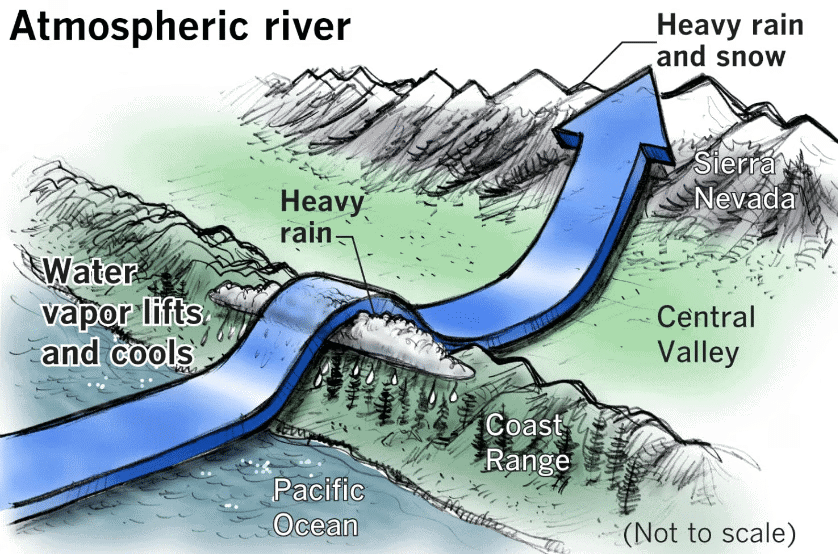CLAT Exam > CLAT Notes > Current Affairs & General Knowledge > Geography: April 2025 Current Affairs
Geography: April 2025 Current Affairs | Current Affairs & General Knowledge - CLAT PDF Download
Atmospheric River

Why in News?
In April 2025, the United States faced significant weather disturbances characterized by heavy rainfall, strong winds, and severe thunderstorms. These conditions were attributed to a meteorological phenomenon known as an Atmospheric River (AR). The increasing frequency of such events has drawn attention to the impact of climate change on weather patterns.
Key Takeaways
- An Atmospheric River is a long, narrow band in the atmosphere that transports large amounts of water vapor from tropical oceans to continental areas.
- The 'Pineapple Express' is a notable example of AR storms that primarily affect the US West Coast, especially California.
Additional Details
- Characteristics:
- Shape & Size: ARs can extend up to 1,600 km in length and can vary from 400 to 600 km in width, as noted by the National Oceanic and Atmospheric Administration (NOAA).
- Moisture Content: They can carry water vapor equivalent to the average flow of the Mississippi River, with the most intense ARs transporting up to 15 times more.
- Categories of Atmospheric Rivers:
- Category 1 (Weak): Generally beneficial, aiding soil moisture and drought recovery.
- Category 2 (Moderate): Benefits reservoirs but can lead to localized flooding if rain persists.
- Category 3 (Strong): A mix of benefits and hazards; while it replenishes water supplies, it also poses flooding risks.
- Category 4 (Extreme): Predominantly hazardous, capable of causing severe flooding but can assist in drought recovery.
- Category 5 (Exceptional): Primarily hazardous, leading to catastrophic flooding and significant economic losses.
- Formation: ARs develop when warm ocean waters, particularly in tropical or subtropical regions, lead to high evaporation rates, which saturate the atmosphere with moisture. This moisture is then directed toward mid-latitudes by low-level jet streams and condenses into precipitation when it encounters mountains or fronts.
- Significance: Atmospheric Rivers play a crucial role in replenishing water supplies and contribute to over 90% of poleward water vapor transport in mid-latitudes. Their landfall can result in extreme precipitation.
- AR in India: Between 1951 and 2020, India recorded 596 major AR events, mostly during the summer monsoon. Significant floods, including the 2013 Uttarakhand floods and the 2018 Kerala floods, were linked to these events, which have become more frequent and severe in recent decades.
- Impact of Climate Change: Rising global temperatures are intensifying AR impacts. For every 1°C increase, air can hold approximately 7% more moisture, making storms fueled by ARs more potent. Future projections suggest that ARs will become longer, wider, and more intense, thereby doubling the occurrence of extreme AR events and heightening flood risks.
The increasing prevalence and intensity of Atmospheric Rivers underscore the need for enhanced understanding and preparedness against their potentially devastating impacts, particularly in vulnerable regions.
The document Geography: April 2025 Current Affairs | Current Affairs & General Knowledge - CLAT is a part of the CLAT Course Current Affairs & General Knowledge.
All you need of CLAT at this link: CLAT
|
98 videos|939 docs|33 tests
|
FAQs on Geography: April 2025 Current Affairs - Current Affairs & General Knowledge - CLAT
| 1. What is an Atmospheric River and how does it impact weather patterns? |  |
Ans. An Atmospheric River is a narrow corridor of concentrated moisture in the atmosphere that can transport large amounts of water vapor from tropical regions to other areas. These systems can lead to significant rainfall and snowfall, causing flooding, landslides, and other weather-related issues when they make landfall.
| 2. How do Atmospheric Rivers contribute to climate change? |  |
Ans. Atmospheric Rivers can exacerbate the effects of climate change by influencing precipitation patterns and increasing the intensity of storms. As global temperatures rise, the atmosphere can hold more moisture, potentially leading to stronger and more frequent Atmospheric Rivers, which can increase the risk of extreme weather events.
| 3. What areas are most affected by Atmospheric Rivers? |  |
Ans. Coastal regions, particularly along the West Coast of the United States, are most affected by Atmospheric Rivers. States like California, Oregon, and Washington often experience heavy rainfall and associated flooding due to these weather phenomena, especially during the winter months.
| 4. How can communities prepare for the impacts of Atmospheric Rivers? |  |
Ans. Communities can prepare for Atmospheric Rivers by investing in infrastructure improvements, such as better drainage systems, flood barriers, and early warning systems. Additionally, public education on emergency preparedness and evacuation plans can help reduce risks associated with heavy rainfall and flooding.
| 5. What are the differences between Atmospheric Rivers and traditional weather systems? |  |
Ans. Unlike traditional weather systems, which may bring scattered rain or snow, Atmospheric Rivers are characterized by their concentrated streams of moisture that can lead to intense and prolonged precipitation. They often result in more significant weather impacts over shorter periods, making them distinct in their behavior and effects on the environment.
Related Searches





















